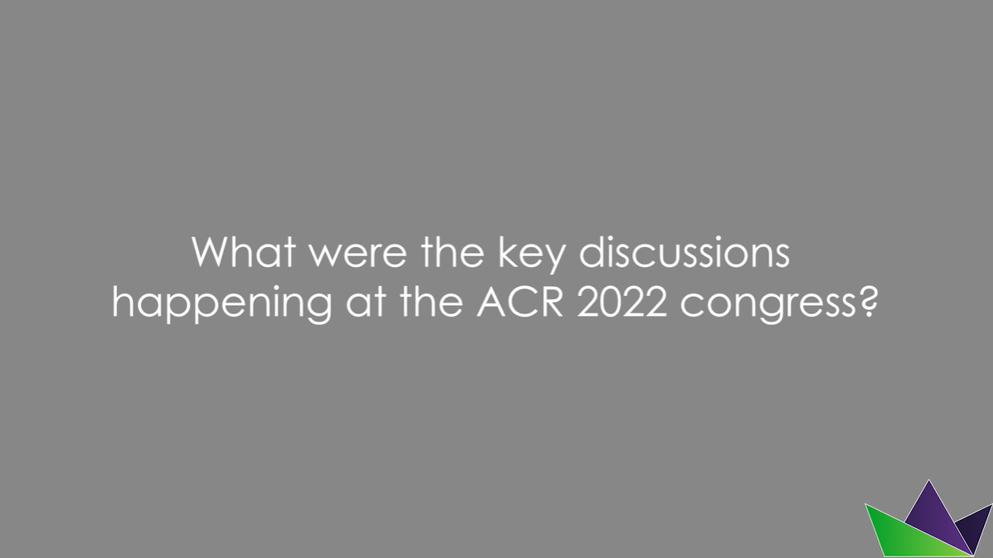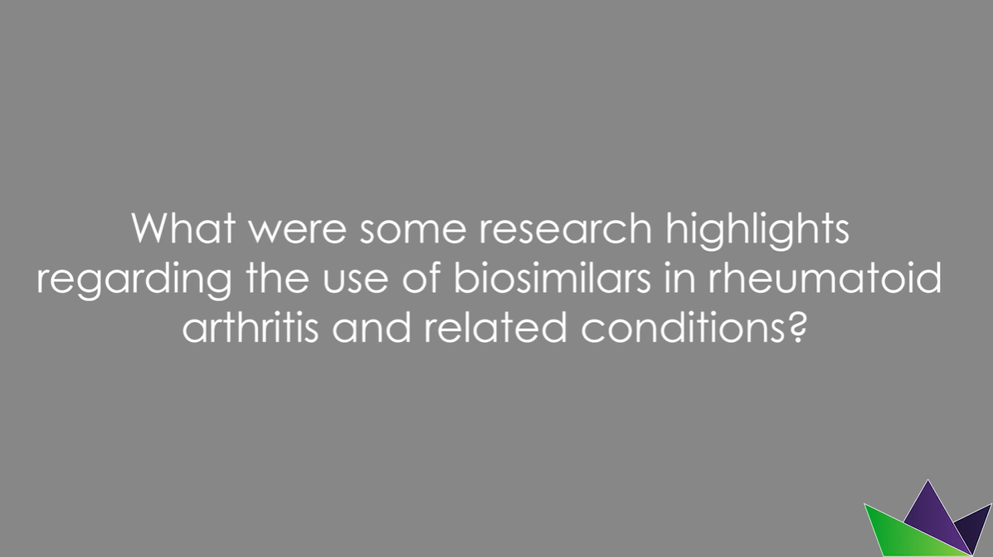
ACR 2022 Congress Highlights
Clinical trial updates on biosimilars in RA, IBD, and more
By Dawn O’Shea
Biologics have revolutionised the management of rheumatic diseases, but the cost of treatment puts biotherapeutics out of reach for many patients. Hence, there is a need for more affordable options. A substantial proportion of research presented at the American College of Rheumatologists (ACR) 2022 annual congress in Philadelphia, Pennsylvania focused on the efficacy and safety of biosimilars as alternatives to more expensive reference therapies.
Transition from adalimumab to SB5 in rheumatoid arthritis, axial spondyloarthritis and psoriatic arthritis
Ulf Müller-Ladner (Justus-Liebig-Universität, Germany), presented the findings of an umbrella analysis of pan-EU data on transition from adalimumab to the biosimilar SB5 in people with rheumatoid arthritis (RA), axial spondyloarthritis (axSpA) or psoriatic arthritis (PsA)1.
A cohort of 1040 patients were followed for 48 weeks post-transmission to SB5 after 16 weeks of routine treatment with adalimumab. Of the 496 patients included in the final analysis, 487 completed the study follow-up. The probability for persistence at 48 weeks was 85.9% of participants with RA, 79.5% of those with axSpA and 81.1% of those with PsA.
The data were also analysed for candidate predictors of persistence on SB5 therapy, including gender, medical history, age, duration of disease, disease severity and concomitant treatments.
Of the evaluated contributing factors, being female was the only factor to show significant association with SB5 persistence
Tocilizumab biosimilar BAT1806 in moderate-to-severe RA
Xiaomei Leng (Peking Union Medical College Hospital, China) presented the findings of a phase 3 randomised controlled trial (RCT) of a proposed tocilizumab biosimilar BAT1806 (also referred to as BIIB800) compared to reference tocilizumab, among people with moderate-to-severe RA with an inadequate response to methotrexate2.
The study included 621 people who had received a diagnosis of RA at least six months previously. They were randomised to one of three treatment groups:
- BAT1806 up to Week 48
- Tocilizumab up to Week 48
- Tocilizumab up to Week 24, followed by BAT1806 to Week 48, administered intravenously at a dose of 8 mg/kg every four weeks
Efficacy was assessed according to ACR20/50/70 response probabilities, as well as DAS28-ESR and DAS28-CRP. At Week 48, mean change in DAS28-ESR and DAS28-CRP from baseline was comparable across groups.
The proportion of ACR20 responders in each treatment groups was 90.4%, 90.3%, and 87.8%, respectively
Safety profiles were similar in all treatment arms, and no new safety or clinically relevant immunogenicity issues were observed in subjects switched from tocilizumab to BAT1806.
Anti-drug antibodies were reported at least once in 21.0% of participants in Group 1, 16.2% in Group 2, and 18.6% in Group 3. All but one in the tocilizumab group tested positive for neutralising antibodies.
Infliximab: ReFLECT study of CT-P13
Two posters on infliximab (IFX) biosimilars featured in Sunday’s sessions, including two-year findings of the multicentre, prospective, observational ReFLECT study of CT-P13, the first monoclonal antibody biosimilar of infliximab3. The real-world study included 751 patients with an inflammatory bowel disease, and 649 with a rheumatic disease, including 142 patients with RA, 411 with axSpA, and 96 with PsA.
Eligible patients were either IFX naive (IFX-N) patients starting CT-P13 or those who have been switched from infliximab to CT-P13 (IFX-S). Treatment maintenance was defined indirectly as the percentage of patients without treatment failure during the two years of follow-up.
Between 70% and 80% of participants in all indication groups were already receiving CT-P13 at baseline, and up to half were receiving concomitant treatment with methotrexate.
From first administration of CT-P13 to 24 months, there was a higher proportion of participants without treatment failure in the IFX-S versus IFX-N patients with RA (65.4% vs 33%), or AS (66.5% vs 56.6%)
Treatment failure, rather than intolerance, was the main reason for CT-P13 withdrawal in both naive and switched participants.
More than half of participants reported at least one adverse event (AE). Suspected CT-P13-related AEs occurred in 24.5% of patients, and serious AEs were reported in 11.9%.
Rituximab biosimilar for granulomatosis with polyangiitis
In a small, but interesting study also presented on Sunday, a team from Cleveland Clinic compared the efficacy and safety of the rituximab biosimilar Ruxience® to its originator in maintaining remission in patients with granulomatosis with polyangiitis (GPA)4. The retrospective single-centre study included 43 adults with GPA who were in remission after at least one year of rituximab maintenance treatment, and then transitioned to an equivalent dose of the biosimilar.
After six months of treatment with Ruxience®, almost 98% of patients remained in remission
One patient experienced a non-severe disease relapse, but there were no severe relapses.
This is a small sample of the many biosimilar studies presented at ACR 2022, and indicates the bright future for patients and healthcare systems who have had limited access to highly effective treatment options
Check in tomorrow for more of the best from ACR 2022.
The latest on biosimilars for axial spondyloarthritis
By Dawn O’Shea
While the global incidence of axial spondyloarthritis (axSpA) is uncertain, studies suggest rates between 0.4 and 15.0 per 100,000 patient-years5. Many of these patients will rotate through several different medications, including expensive biologics6.
Biosimilars provide an opportunity to reduce the cost of treatment, and thereby improve access and outcomes for people with axSpA
Clinical trial: Effect of adalimumab on radiographic progression in radiographic axial spondyloarthritis
In a late-breaking poster presented on Monday, Xenofon Baraliakos presented the result of a phase 3b study comparing the rate of spinal radiographic progression in bio-naïve patients with active radiographic axSpA (r-axSpA) receiving either secukinumab, or the adalimumab biosimilar SDZ-ADL7.
Participant eligibility
- Bath Ankylosing Spondylitis Disease Activity Index (BASDAI) ≥4
- A spinal pain score ≥4 (range 0–10)
- Total back pain score ≥40 mm (range 0–100 mm)
- High-sensitivity C-reactive protein (hsCRP) ≥5 mg/L or ≥1 syndesmophytes
Of 859 participants, 287 received secukinumab 150 mg, 286 received secukinumab 300 mg, and 286 received SDZ-ADL.
Baseline data
- The modified Stoke Ankylosing Spondylitis Spinal Score (mSASSS) was 16.6
- BASDAI was 7.1, hsCRP was 20.4 mg/L
- 73% had ≥1 syndesmophytes
This showed that this study cohort had a high risk of radiographic progression. Mean baseline MRI oedema scores were 1.6–2.5 for the sacroiliac joint (SIJ) and 2.6–3.4 for the spine.
Primary outcome: proportion of participants with no radiographic progression
At Week 104, the proportion of participants with no radiographic progression (change from baseline [CFB]-mSASSS ≤0.5) was:
- 66.1% with secukinumab 150 mg
- 66.9% with secukinumab 300 mg
- 65.6% with the biosimilar
Secondary outcomes
Mean CFB-mSASSS was 0.54, 0.55, and 0.72 in the secukinumab 150 mg, 300 mg, and SDZ-ADL arms, respectively.
After 16 weeks of treatment, mean CFB-MRI SIJ inflammation scores were -1.22, -1.10, and -1.51, and mean CFB-MRI spine scores were -1.43, -1.59, and -2.31.
Real-world study: response to adalimumab and etanercept in axial spondyloarthritis
In a retrospective tertiary care observational study, treatment response to biosimilars adalimumab and etanercept was compared with the originator molecule in biological disease-modifying antirheumatic drug (bDMARD)-naïve patients with axSpA8. They compared treatment response in patients who switched from bio-originator to biosimilar.
Study procedure
Of 154 participants receiving adalimumab, 83 patients started on the originator, 31 on the biosimilar, and 40 switched from the bio-originator to the biosimilar. Of the 74 patients receiving etanercept, 25 started on the originator, 33 on the biosimilar, and 16 switched from the bio-originator to a biosimilar.
Persistence rates
Persistence rates were similar across groups, both for adalimumab and etanercept. In the adalimumab arm, people receiving the originator had a three-year persistence rate of 73.5 per cent. The rate was 64.5 per cent for biosimilars, and 77.5 per cent in the switched group. In those receiving etanercept, three-year persistence rates were 96.0 per cent for the originator, 97.0 per cent for the biosimilars and 93.8 per cent in the switched group.
These data show that the long-term efficacy and safety of adalimumab and etanercept are no different to the originator drug
Treatment retention with biosimilars compared to originators in molecule-naïve patients
It may even be that patients prefer biosimilars. Guillaume Larid presented data from another French study, which found that treatment retention was better with biosimilars compared to originators in molecule-naïve patients9.
The multicentre retrospective study used prescription data for people with rheumatoid arthritis, spondyloarthritis or psoriatic arthritis, beginning with etanercept or adalimumab. Of 845 prescriptions analysed, 340 were for the originators, and 505 were for biosimilars. The most common indication was spondyloarthritis (46%), followed by rheumatoid arthritis (28%), then psoriatic arthritis (16%).
Overall:
- The retention rate was superior with biosimilars (39 vs. 23 months; P=0.045)
- Differences in favour of biosimilars were significant in rheumatoid arthritis patients (P=0.041)
- Citrated treatment displayed better retention compared to citrate-free treatments (P=0.014)
In ACR convergence 2022, recent clinical trials with biosimilars for axSpA show the class has potential, and appears well received by patients
Focus on biosimilar switching in rheumatoid arthritis
By Dawn O’Shea
Many studies have shown that switching from an originator biologic DMARD to a biosimilar is an effective treatment approach with a good safety profile, for people with RA. The research focus has now shifted to the efficacy and safety of re-switching between originators and biosimilars, and switching between biosimilars of the same originator.
Switching between reference adalimumab and the biosimilar PF-06410293
On Sunday, Dr Roy Fleischmann presented the findings of a study looking at multiple switching between the adalimumab biosimilar PF-06410293 and reference adalimumab in combination with methotrexate in patients with moderately to severely active RA10.
Data were categorised into four treatment periods (TP 1–4). There were three switches: first from the originator in TP1 to the biosimilar during TP2, back to the originator in TP3, and finally the biosimilar in TP4.
A total of 445 participants were enrolled. Of these, 427 completed TP1. Eighteen (4%) patients discontinued, 12 due to adverse events (AEs).
Maximum observed serum concentration (Cmax) and area under the plasma concentration-time curve overdosing interval (AUCtau) were measured at Week 30 to Week 32 and showed pharmacokinetic equivalence between switching and non-switching arms.
The proportion of participants with neutralising antibodies (NAb) was similar between switching and non-switching participants at randomisation and remained similar throughout the study.
These findings show that switching between reference adalimumab and the biosimilar PF-06410293 does not present any greater risk of immunogenicity, safety, nor the possibility of diminishing efficacy over time with the biosimilar than with continued treatment with the originator
Biosimilar-to-biosimilar switching in routine care: results from the DANBIO registry
At a plenary session, Dr Hafsah Nabi presented the findings of a nationwide Danish study looking at the effects of switching between infliximab biosimilars11.
In May 2015, Denmark implemented a national guideline mandating that patients receiving reference infliximab should be switched to the biosimilar CT-P1312. The results presented by Dr Nabi are based on data from patients with RA, psoriatic arthritis (PsA) or axial spondyloarthritis (AxSpA) who were switched from CT-P13 to another infliximab biosimilar (GP1111) between April 1, 2019 and February 1, 2020.
Of the 1605 patients included, 685 had RA, 314 had PsA, and 606 had AxSpA. Median disease duration was nine years, and 37% were in remission according to the clinical disease activity index and ankylosing spondylitis disease activity score. The cohort included infliximab-naive patients (n=1171) and those who had previously been switched from the originator to CT-P13.
The primary outcomes were one-year GP1111 treatment retention and changes in disease activity four months before versus four months after the switch from CT-P13.
One-year retention rates of GP111 were 83% in the originator-naive group and 92% in the originator-experienced group. Changes in disease activity four months pre- and post-switch were close to zero for all disease activity measures.
In patients with RA, GP1111 retention rates were higher in the originator-experienced compared to originator-naive groups (HR=0.4). This was similar in PsA patients (HR=0.2), but not in those with AxSpA (HR=0.6).
In this era of frequent switching, the findings provide reassurance on the interchangeability of infliximab biosimilars
Two-year results from ReFLECT: real world use of CT-P13
Continuing the theme of CT-P13, Professor Bruno Fautrel presented two-year data from the ReFLECT study which compared the biosimilar to reference infliximab in the real world13.
Of 1400 adults included in this multicentre, prospective, observational study, 751 had an inflammatory bowel disease and 649 had a rheumatic disease, including 142 with RA, 411 with ankylosing spondylitis (AS), and 96 with PsA. This cohort included infliximab-naive patients (IFX-N) starting CT-P13 and those who had been switched from infliximab originator to CT-P13 (IFX-S).
From the first administration of CT-P13 to 24 months follow-up, there was a higher proportion of patients without treatment failure in IFX-S patients versus IFX-N patients. Rates of 65.4% versus 33.3% were seen in RA patients, while the corresponding rates were 66.5% versus 56.6% in those with AS, and 75.9% versus 72.0% with PsA.
The main reason for CT-P13 withdrawal, in both naive and switched patient, was treatment failure, which was more common among infliximab-naive patients
ACR Highlights Interview
Discover the latest developments in the evolving landscape of biosimilars presented at the ACR Convergence 2022 Congress.
Dr Ben Gallarda, PhD, discusses key highlights from the ACR congress including:
- Latest scientific breakthroughs including results from the GLORIA study, updates to ACR guidelines for vaccination and changes to labelling requirements for JAK inhibitors
- Comparisons between the performance of various biosimilars and originator treatment
- Non-clinical developments such as defining pre-rheumatoid arthritis and patient centric approaches for treatment of older patients
Faculty
Meet Dr Ben Gallarda, PhD
Dr Ben Gallarda, PhD
Head of Scientific Services with EPG Health, responsible for all content on Medthority.
Ben received his PhD in biology, focusing on neuroscience from the University of California, San Diego and the Salk Institute for Biological Studies. He continued his neuroscience research at l’Institut Pasteur in Paris, France, after which he began working in international medical communications. Having written, edited, or produced thousands of pieces of medical content in 8 different languages in therapeutic areas such as oncology, neurology, dermatology, cardiology, rheumatology, infectious diseases, immunology, ophthalmology and more, Ben now leads a team of expert medical writers to produce medical educational content for Medthority.
Disclosures: GSK shareholder
References
- Müller-Ladner U, Gaffney K, Jadon D, Matucci-Cerinic M, Chamizo Carmona E, Addison J. A 48-week Analysis of a Pan-EU Real-world Study of SB5 Biosimilar Following Transition from Reference Adalimumab in Patients with Rheumatoid Arthritis, Axial Spondyloarthritis or Psoriatic Arthritis. Arthritis Rheumatol. 2022;74.
- Leng X, Leszczynski P, Jeka S, Liu S, Liu H, Miakisz M, et al. Fifty-two-week Results from a Phase 3, Randomized, Double-blind, Active-controlled Clinical Trial to Compare BAT1806/BIIB800, a Proposed Tocilizumab Biosimilar, with a Tocilizumab Reference Product in Subjects with Moderate to Severe RA with an Inadequate Response to Methotrexate. Arthritis Rheumatol. 2022;74.
- Fautrel B, Assing M, Mammar N, Brault Y, H. M. Year-two Follow-up Results of an Observational Study Conducted in Rheumatoid Arthritis, Ankylosing Spondylitis and Psoriatic Arthritis Patients Treated with Infliximab Biosimilar CT-P13 in a Real-life Setting. Arthritis Rheumatol. 2022;74.
- Vural A, Mushtaq K, Zhang C, Alwakeel M, Sayles V, Duly K. Efficacy and Safety Assessment of a Rituximab Biosimilar in Patients with Granulomatosis with Polyangiitis (GPA). Arthritis Rheumatol. 2022;74.
- Bohn R, Cooney M, Deodhar A, Curtis JR, Golembesky A. Incidence and prevalence of axial spondyloarthritis: methodologic challenges and gaps in the literature. Clin Exp Rheumatol. 2018;36(2):263–274.
- Di Giuseppe D, Lindström U, Aaltonen K, Relas H, Provan S, Gudbjornsson B, et al. The occurrence of multiple treatment switches in axial spondyloarthritis. Results from five Nordic rheumatology registries. Rheumatol. 2022;61(9):3647–3656.
- Baraliakos X. Effect of Secukinumab versus Adalimumab Biosimilar on Radiographic Progression in Patients with Radiographic Axial Spondyloarthritis: A Randomized Phase IIIb Study. Abstract L15. Presented at the ACR Convergence 2022. Available at: https://meet.acrconvergence2022.org/meetings/virtual/poster/aLkfvHSMMxBKSRFbb.
- Martins Fernandes A. Long-term Follow-up of Starting and Switching from Bio-originator to Biosimilar: Real-world Data in Axial Spondyloarthritis Patients Treated with Adalimumab and Etanercept. Abstract 0431. Presented at the ACR Convergence 2022. Available at: https://meet.acrconvergence2022.org/meetings/virtual/poster/yhZXFkTDEzJkKXRPb.
- Larid G. Differential Retention of Adalimumab and Etanercept Biosimilars Compared to Originator Treatments: Results of a Retrospective French Multicentre Study. Abstract 1039. Presented at the ACR Convergence 2022. Available at: https://meet.acrconvergence2022.org/meetings/virtual/poster/LPxK3Kt5tGrc54PHj
- Fleischmann R, Lakhanpal S, Saikali W, Alvarez D, Cox DS, Ianos C, et al. Multiple Switching Between the Biosimilar Adalimumab PF-06410293 (Abrilada™) and Reference Adalimumab (Humira®)in Combination with Methotrexate in Patients with Moderately to Severely Active Rheumatoid Arthritis. Presented at the ACR Convergence 2022. Abstract 1589. Available at: https://acrabstracts.org/abstract/multiple-switching-between-the-biosimilar-adalimumab-pf-06410293-abrilada-and-reference-adalimumab-humirain-combination-with-methotrexate-in-patients-with-moderately-to-severely-act/.
- Nabi H, Hendricks O, Jensen DV, Loft AG, Pedersen J, Just S, et al. Biosimilar-to-Biosimilar Switching in Routine Care – Results on >1,600 Patients with Inflammatory Arthritis in the DANBIO Registry. Presented at the ACR Convergence 2022. Abstract 1112. Available at: https://acrabstracts.org/abstract/biosimilar-to-biosimilar-switching-in-routine-care-results-on-1600-patients-with-inflammatory-arthritis-in-the-danbio-registry/.
- Danish infliximab switching study shows no difference. https://www.gabionline.net/biosimilars/research/Danish-infliximab-switching-study-shows-no-difference.
- Fautrel B, Assing M, Mammar N, Brault Y, Marotte H. Year-two Follow-up Results of an Observational Study Conducted in Rheumatoid Arthritis, Ankylosing Spondylitis and Psoriatic Arthritis Patients Treated with Infliximab Biosimilar CT-P13 in a Real-life Setting. Presented at the ACR Convergence 2022 2022. Abstract 1426. Available at: https://acrabstracts.org/abstract/year-two-follow-up-results-of-an-observational-study-conducted-in-rheumatoid-arthritis-ankylosing-spondylitis-and-psoriatic-arthritis-patients-treated-with-infliximab-biosimilar-ct-p13-in-a-real-life/.
This content has been developed independently by Medthority who previously received educational funding in order to help provide its healthcare professional members with access to the highest quality medical and scientific information, education and associated relevant content.



